Journal of Geography & Natural Disasters
Open Access
ISSN: 2167-0587
ISSN: 2167-0587
Research Article - (2023)Volume 10, Issue 1
The key sources of water supply are rain water, underground water and surface water. Rooftop rain water harvesting is a technique through which the rain is captured from the roof catchments and. The objective of this study was rooftop rain water harvesting potential for a domestic purpose using samsam water tool. This can be used in dry and wet seasonal situation based up on the roof size and population density, which plays a crucial role in socioeconomic development and keeping the community school welfare. The RTRWH is the most reliable, easiest to access, and suitable source for water supply. This study was carried out from June 2018 to December 2019 based on case study of 3 Jimma University Institute of technology Kito furdisa campus. Since this rainfall data, rooftop catchment, water consumption and water demand data were used as an input. Based on the findings the annual rainfall is 1846 mm. The total roof size of the school is 888.32 m2 and almost the entire age of the building is ranges between 5 years-15 years which has been constructed by galvanized iron in which its run off coefficient is estimated to 90%. The collected data have been analyzed using different tools including samsam water RWH model, and SPSS statistics version 22. As a result, the volume of harvested rain water was 12,826 m3/ yr. which cover all non-potable water needs for 14,458 of school population. The total yearly water requirement for a working day (182 days) and working days plus none working days (365 day) of the school is 18,606.72 m3/yr and 26,759.47 m3/yr. respectively. The reliability of harvested rainwater from the rooftop for the community school can be meeting about 63.4 % of water scarcity reduced by feeding for (365 days). Whereas the reliability of rainwater harvested potential is 82% of water demand can be meeting by considering the schedule of working days (9 months). The averagely reliable for the study area is great than 72.6% of water demand.
Domestic; Potential; Rooftop; Rainwater harvesting; Samsam water
Water is a basic human requirement which may be sourced from surface water, groundwater, or rainwater. Today sources this is becoming to diminish due to the population rise, climate change, and pollution, which causing as global water scarcity, especially in developing countries. According to a study estimate reported by, more than 2000 million people lives under the condition of high-water stress by the year of 2050, which are the main factors that can affect the socioeconomic development of any country. Basically, the quality of life depends on the adequate supply of fresh water, which can be influenced by population dynamics which is imposed heavy pressure on fresh water resources through increased water demand and pollution. The rooftop rainwater harvesting is the most economy and easier technical method of conserving water. This paper deals with the rooftop rainwater harvesting potential in Agaro towns’ community school by using samsam rainwater harvesting tool. The shortage of water has become a serious problem over the world and is assumed to be related to the increase in population, rapid urbanization and climatic changes [1-2].
Jimma university institute of technology in Kito furdisa campus is one of the mostly inhabited in university and rapid urbanization area. This is leading to overpopulation and increasing water demand which doubles to water consumption rates. Thus way, the roof top rainwater harvesting is the solutions for reducing the problem of water scarcity, for both surface and sub-surface water sources is inadequate or insignificant quality [3].
Description of the study area
The study was conducted in Oromia regional state, of Jimma zone in Jimma University Institute of technology Kito furdisa campus. Geographically this area is located between 7°51′ N and 36°35′ E which is 346 km far away from Addis Ababa city.
Population study
The main objective of any water supply distribution is to provide safe and adequate potable water to the beneficiaries. The main user of the RTWH is the whole community school those found in JIT campus of two student dorm block, so the forecasted community population where listed in below Table 1 is the number of students and staff members respectively.
| No | Name of student dorm | Men | Female | Sum |
|---|---|---|---|---|
| 1 | Block 3 | 9226 | ||
| 2 | Block 4 | 2730 | ||
| 3 | Block 5 | 1464 | ||
| 4 | Total community school populations | 14,458 |
Table 1: Study population observed for Jimma zone in jimma university institute of technology Kito furdisa campus.
Determination of roof catchment area
Roof catchment rainwater harvesting system basically consists of the roof top that provides the catchment area that should to be measured in the field directly. This was obtained by the mathematical language of multiplying the length (m) by width (m), if rectangular roofs, but it depends on shape of catchment.
Therefore, for each section of the class room, since their shape is rectangular form it can be determined using the (Area of the roof catchment (A)=width*length). Basically, for each community schools the summation of the roof catchment area for harvesting rain water to meet the raising water demand to each community’s school is listed in below Table 2.
| JIT Kito furdisa campus estimation of rooftop catchment for three student rooftop catchment for three student | |
|---|---|
| Name of dorms | Average roof area (m2) |
| Block 3 | 524.32 |
| Block 4 | 223.32 |
| Block 5 | 241.5 |
Table 2: Estimation of school rooftop catchment area.
Average age of rooftop
The roof catchment area is the location point through which rain water is harvested from the rooftops; however, the age of roof material has been affecting both the qualities, and quantities of rainwater harvested potential. The age of the roof material is the main factor which can influence the quality and quantity of rainwater harvesting potential. When it’s very old age it requires more time of first flushing, which can be used for non-potable purpose. It has been identified that the types of roof material for the school roof is galvanized iron with the medium age of 5 years∼15 years old. The age of building has been described in five-year intervals for simplification of estimation the age of roof material.
Average water consumption rates for JIT kito furdisa campus student dorms
The water source for JIT Kito furdisa campus is identified to be ground water source, which was not enough for distributing to the community school. The average water consumption rates of (students, staff members and other) those stay in the higher education, colleges and secondary or primary school were vary based up on the time of delaying. Thus way, the averagely water consumption rate for the school community can be classified into a board school and school day is 5 l/pupil per a day school and 60l/pupil for board school or campus services [4].
Estimation of water demand for community school
The water demand was varying for wet and dry seasons, for instance during wet season there were high excessive rain water harvested and less consumption rates that has be stored for some dry months. This can be basically depending on the number of hours to be stayed at school for instance the excluding the weekends there are 22 working days in each month. Among this day the students can be stayed maximum for 24 hrs per days (Table 3).
| Month | Working (days) | weekends and non-working | Average water consumption (lpd) | Population no | Monthly water demand (m3/month) | Annual water demand (m3/year) |
|---|---|---|---|---|---|---|
| Jan | 14 | 16 | 5 | 14, 458 | 942.06 | 18,370.17 |
| Feb | 19 | 11 | 1278.5 | |||
| Mar | 22 | 8 | 1490.4 | |||
| Apr | 21 | 9 | 1413.1 | |||
| May | 20 | 10 | 1345.8 | |||
| Jun | 16 | 14 | 1076.6 | |||
| Jul | 30 | 0 | ||||
| Aug | 30 | 0 | ||||
| Sept | 22 | 8 | 1480.4 | |||
| Oct | 18 | 12 | 1211.2 | |||
| Nov | 12 | 18 | 807.5 | |||
| Dec | 18 | 12 | 1211.2 | |||
| Annual | 30 days | 20 | 389 for staff | 42.75 | 236.55 | |
| Total | 182 | 178 | 12,299.51 | 18,606.72 | ||
Table 3: Estimation of water demand for community school.
Rainwater harvesting potential results for JIT kito furdisa campus, student dorm block 3
The optimum size for a storage reservoir for this rainwater harvesting system is 369,700 liters (369.7 m³) and the details of the results and calculations were found in below (Figure 1 and Table 4).
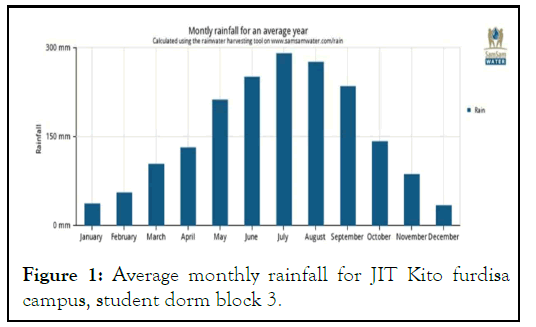
Figure 1: Average monthly rainfall for JIT Kito furdisa campus, student dorm block 3.
| Latitude | Longitude | Roof size | Roof type | Roof type | Water demand |
|---|---|---|---|---|---|
| 7.85º | 36.57º | 885.36 m2 | Steel | 0.9 | 3945 l/d |
Location: JIT Kito furdisa campus, student dorm block 3 Jimma, Ethiopia
Table 4: Location, Roof material type and water consumption rates for Jidda secondary high school.
Water availability for JIT kito furdisa campus, student dorm block 3
The type of roof top material is a galvanized iron which has a runoff coefficient of 0.9, which means that 90% of the rain can be harvested.
Based on this runoff coefficient and the roof catchment areas of the schools were 885.36 square meters and the volume of 26,375 liters (33.1 mm × 885.36 m2 × 0.9) of water can be collected in the driest month (December) and 230760 litres (289.6 mm × 30 m2 × 0.9) in the wettest month (July). The total yearly amount of water that can be collected from the roof is 1,471,200 litres (1471 m3) in an average year [5].
Water demand for JIT Kito furdisa campus, student dorm block 3
The daily water needs of Jidda secondary high school was 3945 litres per day, which equals to about 118,350 litres per month. Therefore, the average yearly water demand of the school was for about, 1439,900 litres (1439.925 m3) per year. Thus, during five months of the year (May, June, July, August and September) the amount of water could be collected from the roof top is larger than the water demand. The excess water should have to be stored to be used in the months where the water availability is smaller than the average demand (Figure 2).
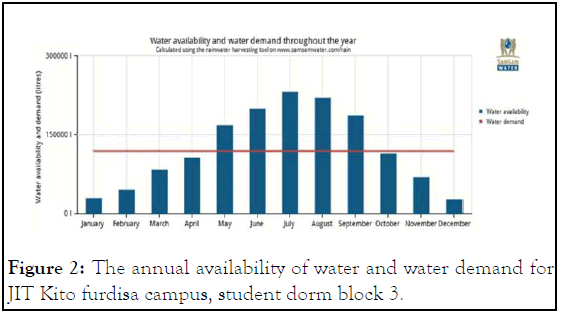
Figure 2: The annual availability of water and water demand for JIT Kito furdisa campus, student dorm block 3.
The average annual water demand and monthly demand were described in the below Figure 3 for this community schools were plotted against the rooftop rainwater available.
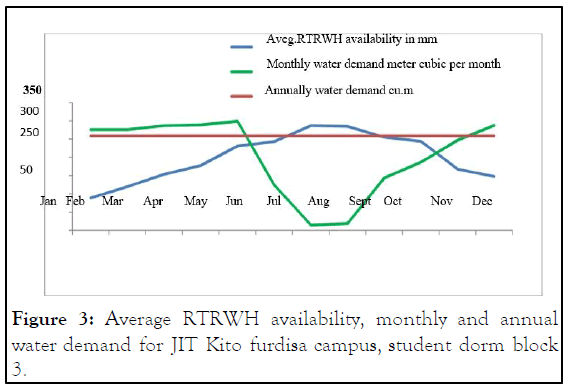
Figure 3: Average RTRWH availability, monthly and annual water demand for JIT Kito furdisa campus, student dorm block 3.
The required storage tank for JIT Kito furdisa campus, student dorm block 3
The storage tank that requires for this school was constructed to collect and store the water during the wet months so this water can be used during the dry months. For this location, roof size and water demand the optimum size of a storage tank is 369,700 litres (369.7 m3).The storage reservoir will be full in and then slowly drain until it is (almost) empty (Figure 4).
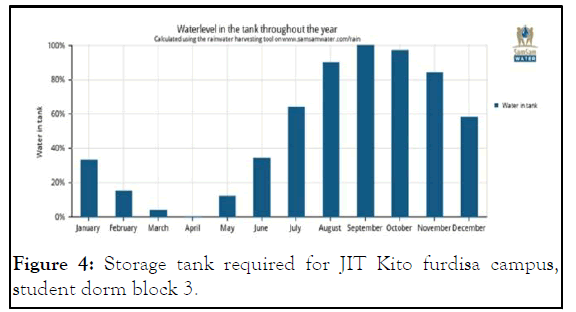
Figure 4: Storage tank required for JIT Kito furdisa campus, student dorm block 3.
Dry and wet months
The dry and wet situation of annual calculation is based on the average monthly rainfall. The actual rainfall differs from month to month and year to year. The amount of available water and filling of the tank might therefore be different and change from year to year. When constructing a rainwater harvesting system it is important to take this into account. Below is a description of the situation in a dry year (20% chance) and a wet year (20% chance). Situation in a dry year: there is no need to take additional measures. Situation in a wet year: there would be more than enough water. There is no need to take additional measures [6].
Rainwater harvesting potential for JIT Kito furdisa campus, student dorm block 4
The total amount of water that can be collected from this roof is not enough to fulfill the total water demand. However, it might still be worthwhile to construct a rainwater harvesting system. With a storage reservoir of 404,900 litres (404.9 m³) a rainwater harvesting system could provide 4208 litres of water per day, which is 52% of the total demand. The details of the results and calculations were described in below Table 5.
| Latitude | Longitude | Roof size | Roof type | Runoff coeff | Water demand |
|---|---|---|---|---|---|
| 7.85º | 36.57º | 924.32 m2 | Metal | 0.9 | 8135 l/d |
Location: JIT Kito furdisa campus, student dorm block 4 Jimma town, Ethiopia
Table 5: Location, Roof material type and characterizes of water consumption rates for student dorm block 4.
Location: JIT Kito furdisa campus, student dorm block 4 Jimma town, Ethiopia
Rainfall for JIT Kito furdisa campus, student dorm block 4
The average rainfall at this location varies between 33.1 mm in the driest month (December) and 289.6 mm in the wettest month (July) and the total annual rainfall is 1846 mm as below Figure 5.
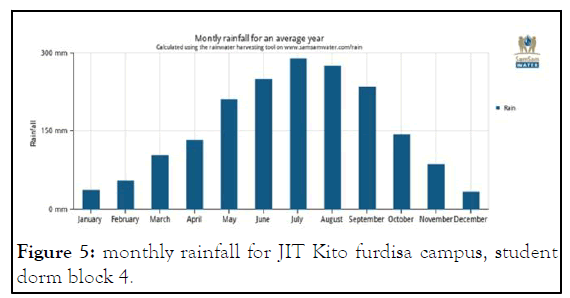
Figure 5: monthly rainfall for JIT Kito furdisa campus, student dorm block 4.
Water availability JIT Kito furdisa campus, student dorm block 4
The Steel roof has a runoff coefficient of 0.9, which means that 90% of the rain can be harvested. Based on this runoff coefficient and a roof area of 924.32 square meters a volume of 27,535 litres (33.1 mm × 924.32 m² × 0.9) of water can be collected in the driest month (December) and 240915 litres (289.6 mm x 30 m² × 0.9) in the wettest month (July). The total yearly amount of water that can be collected from the roof top is 1,535,900 litres (1536 m3) in an average year.
Water demand for JIT Kito furdisa campus, student dorm block 4
The water demand of the school is 8,135 litres per day, which equals to about 244,050 litres per month. The total water demand is 2,969,300 litres (2,969.275 m³) per year. The amount of water that might be collected from the roof (1536 m³) is less than the water demand (2969.275 m³). Only a part of the water demand can be fulfilled using a rainwater harvesting system (Figure 6).
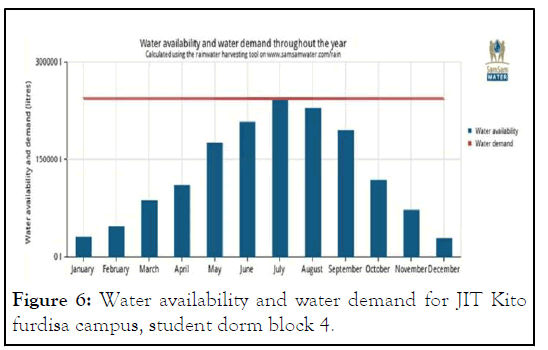
Figure 6: Water availability and water demand for JIT Kito furdisa campus, student dorm block 4.
The average water demand and monthly demand was meeting to rooftop rain water harvesting only in the summary season as indicates in Figure 7.
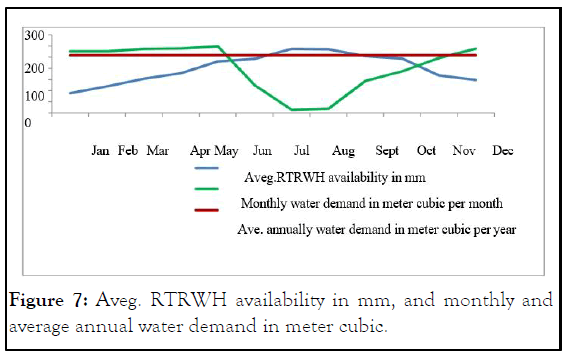
Figure 7: Aveg. RTRWH availability in mm, and monthly and average annual water demand in meter cubic.
The required storage tank for JIT Kito furdisa campus, student dorm block 4
The total amount of water that could be collected from this roof top, 1,535,900 litres, is not enough to fulfil the total annual water demand of 2,969,300 litres. However, it might still be worthwhile to construct a rainwater harvesting system (Figure 8).
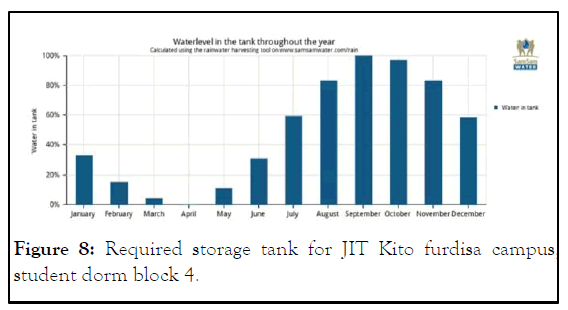
Figure 8: Required storage tank for JIT Kito furdisa campus, student dorm block 4.
Dry and wet months
This calculation is based on the average monthly rainfall. The actual rainfalls were varying from month to month and from year to year. The amount of available water and filling of the tank might therefore be different and change from year to year. When constructing a rainwater harvesting system it is important to take this into account. Below is a description of the situation in a dry year (20% chance) and a wet year (20% chance).
Situation in a dry year: During a dry year, there is less rain to fill the system. The system should provide a smaller amount of water compared to an average year. All rain is stored, so constructing a larger reservoir won't help.
Situation in a wet year: During a wet year there is more water available and constructing a larger tank will increase the water availability in this situation. With a storage reservoir of 463,700 litres (463.7 m³) a rainwater harvesting system could provide 68% of the total demand [7].
Rainfall data for JIT Kito furdisa campus, student dorm block 5
The average rainfall at this location varies between 33.1 mm in the driest month (December) and 289.6 mm in the wettest month (July). The total annual rainfall in an average year is 1846 mm (Figure 9).
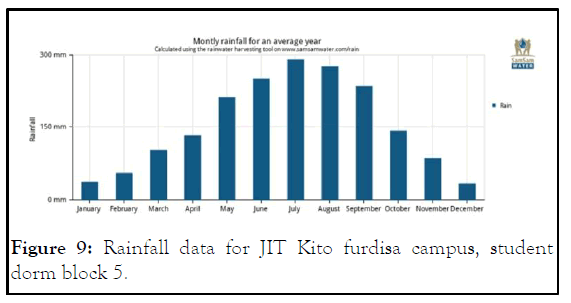
Figure 9: Rainfall data for JIT Kito furdisa campus, student dorm block 5.
Water availability for JIT Kito furdisa campus, student dorm block 5
A metal roof has a runoff coefficient of 0.9, which means that 90% of the rains were harvested. Based on this runoff coefficient and a roof area of 523.32 square meters a volume of 15,590 litres (33.1 mm × 523.32 m² × 0.9) of water can be collected in the driest month (December) and 136,398 litres (289.6 mm × 30 m² × 0.9) in the wettest month (July). The total yearly amount of water that can be collected from the roof is 869,600 litres (870 m³) in an average year.
Water demand for JIT Kito furdisa campus, student dorm block 5
The water demand is 20,000 litres per day, which equals to about 600,000 litres per month. The total water demand is 7300,000 litres (7300 m³) per year. The amount of water that could be collected from the roof (870 m³) is less than the water demand (7300 m³). Only a part of the water demand can be fulfilled using a rainwater harvesting system (Figure 10).
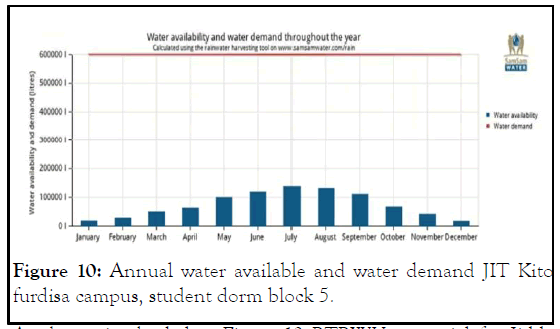
Figure 10: Annual water available and water demand JIT Kito furdisa campus, student dorm block 5.
As shown in the below Figure 10 RTRWH potential for Jidda first primary school did not meeting to the average and monthly water demand, so it needs to search other water source (Figure 11).
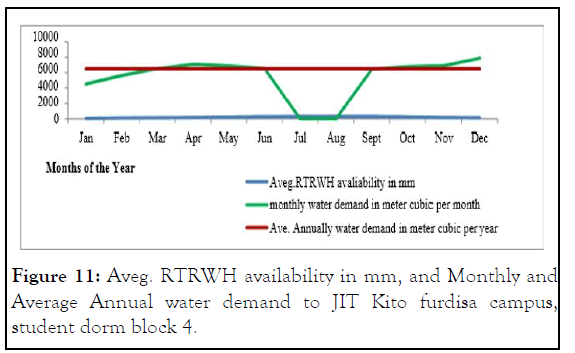
Figure 11: Aveg. RTRWH availability in mm, and Monthly and Average Annual water demand to JIT Kito furdisa campus, student dorm block 4.
The required storage tank for JIT Kito furdisa campus, student dorm block 5
The total amount of water that should be collected from this roof, 869,600 litres, is not enough to fulfil the total yearly water demand of 7300,000 litres. However, it might still be worthwhile to construct a rainwater harvesting system. With a storage reservoir of 229,300 litres (229.3 m³) a rainwater harvesting system could provide 2382 litres of water per day, which is 12% of the total demand. The storage reservoir will be full in and then slowly drain until it is (almost) empty at the end of April (Figure 12).
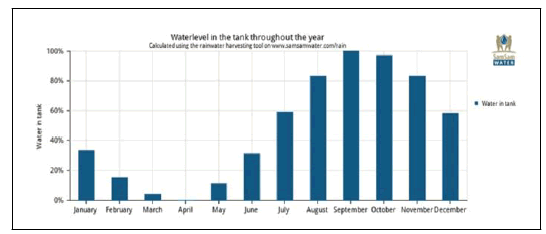
Figure 12: The storage tank level JIT Kito furdisa campus, student dorm block 5.
Dry and wet months
This calculation is based on the average monthly rainfall. The actual rainfall differs from month to month and year to year. The amount of available water and filling of the tank might therefore be different and change from year to year. When constructing a rainwater harvesting system it is important to take this into account. Below is a description of the situation in a dry year (20% chance) and a wet year (20% chance).
Situation in a dry year: During a dry year, there is less rain to fill the system. The system can provide a smaller amount of water compared to an average year. All rain is stored, so constructing a larger reservoir won't help.
Situation in a wet year: During a wet year there is more watter available and constructing a larger tank will increase the water availability in this situation. With a storage reservoir of 262500 litres (262.5 m³) a rainwater harvesting system could provide 16% of the total demand [8].
The roof top rainwater harvesting plays a great role in the socioeconomy development of the country for modelling the health status of the society. However, this can be influenced by roof sizing, community density, run off coefficient and patterns of rain fall. Especially the patterns of rain fall for the study area were varying for seasonal situation. The amount of annual precipitation is rise to 1846 mm, which is almost enough to fulfil demand of the school by (63.4% and 82%) from RTRWH, without searching any other water source. Depending on the above results the accessibility of water supply for this study area is achieving to 63.4% had meeting to the water needs from the roof harvesting in averagely. The amount of harvested rainwater is 12,826 m3/y from the whole roof catchments of 2480.84 m2 with the roof material run off coefficient 90%. Whereas the yearly water requirements to the JIT Kito furdisa campus is for about 26,759.47 m3/y which is overburden for the source of water. The volume of harvested water from each school was satisfy the school demands up to 82%. This contributes to reducing the scarcity of water needs for the JIT Kito furdisa campus, by providing as an alternative solution for increased water demand.
[Crossref] [Google Scholar] [PubMed]
[Crossref] [Google Scholar] [PubMed]
[Crossref] [Google Scholar] [PubMed]
[Crossref] [Google Scholar] [PubMed]
Citation: Ebsa DG (2023) Rooftop Rainwater Harvesting Potential for a Domestic Purpose Using Samsamwater, Case of Jimma University Institute of Technology. J Geogr Nat Disasters. 13:265.
Received: 27-Oct-2022, Manuscript No. JGND-22-19854; Editor assigned: 31-Oct-2022, Pre QC No. JGND-22-19854 (PQ); Reviewed: 14-Nov-2022, QC No. JGND-22-19854; Revised: 06-Feb-2023, Manuscript No. JGND-22-19854 (R); Published: 13-Feb-2023 , DOI: 10.35841/2167-0587.23.13.265
Copyright: © 2023 Ebsa DG. This is an open-access article distributed under the terms of the Creative Commons Attribution License, which permits unrestricted use, distribution, and reproduction in any medium, provided the original author and source are credited.